Guide To The Enchanting Tawang Buddhist Monastery To Visit In 2025
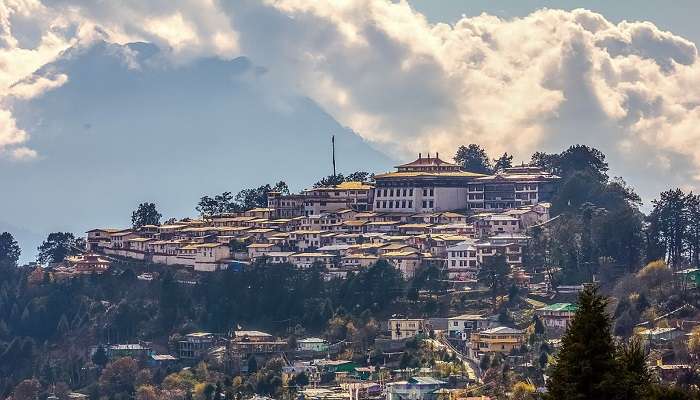
Tawang Buddhist Monastery is located in Tawang, Arunachal Pradesh. It is located in the valley of Tawang Chu and is very close to the Chinese and Bhutanese borders. This monastery in Tibet is known as Gaden Namgyal Lhatse, which translates to the divine paradise of complete victory. Merak Lama Lodre Gyatso founded this monastery between 1680 and 1681. This monastery was built under the wishes of the fifth Dalai Lama, Ngawang Lobsang. Tawang Monastery belongs to the Gelug school of Vajrayana Buddhism. The monastery has three floors and 925 feet long compound walls. There are 65 residential buildings inside the monastery, and it also has a library with many old scriptures, mainly Kangyur and Tengyur.
Everything About The Tawang Buddhist Monastery
Here are a few things to remember before visiting the Tawan Monastery for a knowledgeable and memorable trip.
1. Etymology And Location
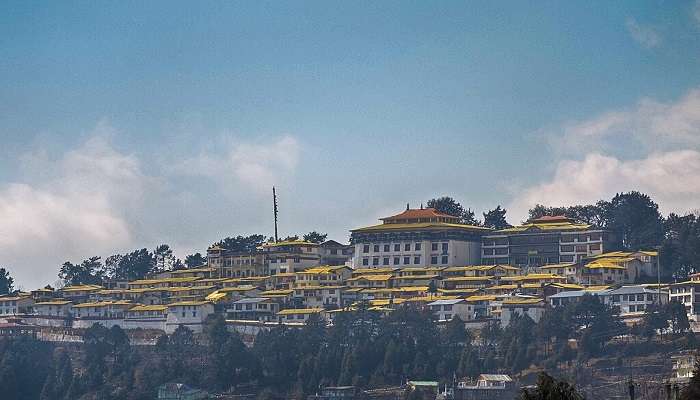
The original name of this monastery is Tawang Galdan Namgye Lhatse. The translation of this monastery’s name is Ta means horse, Wang means chosen; and Tawang means a place selected by horse. Gadan means paradise, Namgyal means complete victory, and Lhatse means divine, and it entirely translates to a location chosen by the horse, the heavenly paradise of complete victory.
The monastery is situated near the top of the mountain, which is 10,000 feet elevated and has a beautiful view of the Tawang Chu valley. This mountain is covered with snow and lush green forests. The monastery is bounded on its southern and western sides by steep ravines formed by streams. It is bordered by a narrow spur and gently sloping ground on the northern and eastern sides. One can enter the monastery from the north direction, which has substantial alpine vegetation.
Must Read: Places To Visit In Tawang
2. Legends About The Establishment Of The Monastery
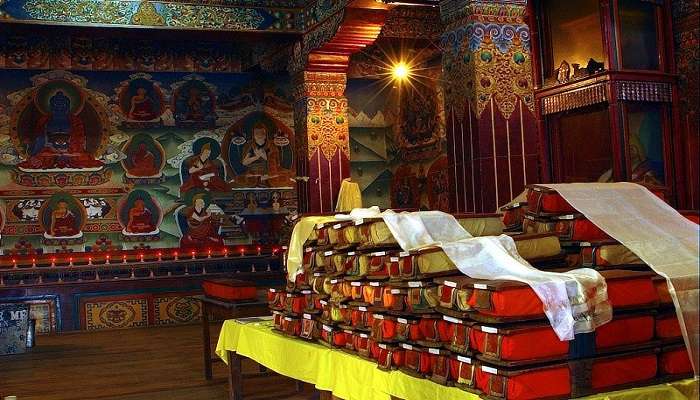
There are three legends regarding the establishment of the monastery. According to the first legend, the monastery’s present location was selected by a horse that belonged to Merag Lama Lodre Gyatso. It was chosen by the horse of the Merag Lama, who went on a mission to establish a monastery ordered by the fifth Dalai Lama. After searching for a long time, he failed to locate a suitable place. He stopped and went into a cave to pray, asking the divine to intervene at a site for him. After he came out of the cave, he found his horse missing. When he searched for it, he found it gazing at the top of a mountain called Tana Mandekhang. This mountain was a palace ruled by King Kala Wangpo in the past. He took this action as divine guidance and decided to establish the monastery. By seeking help from the local people, he established the monastery in 1681.
According to the second legend, Tawang is linked to Terton Pemalinpa, which means diviner of treasures. In this particular location, he said that the initiations of Tamdin and Kagyad resulted in the name Tawang. The third legend says that a white horse had wandered into the Monpa region and belonged to the prince of Lhasa. Many people searched for the horse and found the horse gazing at the location of the monastery. The people then started worshipping the horse and the area where it was found and celebrated it yearly. To honour the sacred place, the Tawang monastery was built at that location. Another legend of a goddess painted Thangka of Palden Lhamo in the monastery is also.
3. Features Of The Tawang Monastery
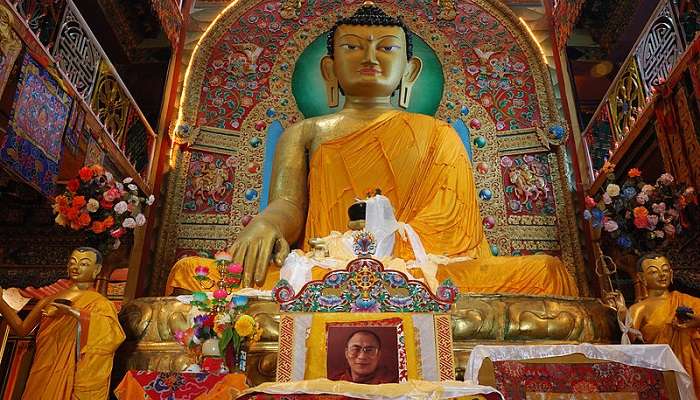
The entrance of the Tawang monastery is a colourful gate known as the Kakaling which is built in the shape of a hut with stone masonry side walls. On the roof of the Kakaling, there are mandalas; on the interior walls, there are many paintings of the murals of divinities and saints. The 9th mural from the Southwest corner of the southern wall is a distinctive mural known as Ningmecahn. It is known as the protector deity of the Bon religion and is also considered the guardian deity of the Tawang region. Ahead of the main gate, to its South, there is another entry gate. This gate has massive doors fitted on the northern wall. The outer wall is 925 feet in length, with a height that varies from 10 to 20 feet. The southern side of the monastery also has another gate with a massive door. According to a legend being told the fifth Dalai Lama gave a role of thread to be bound around the according to a legend being told the fifth Dalai Lama gave a role of thread to be bound around all the walls of the monastery to denote the extent to which the monastery should be built.
The monastery is built like a large mansion with three floors and an assembly hall. There are 10 functional structures and 65 residential quarters for monks, Lama, and students. The monastery has a school, a water supply facility, and a Centre for Buddhist cultural studies. On the underground floor of the monastery, various ritual dances are performed. On the walls of this floor, there are thangkas Buddhist deities. The residential building of this monastery accommodates nearly 700 monks, and currently, 450 marks are residing. There is a footprint on a stone slab on the front porch of the ground floor wall, which is a notable feature because it is believed this footprint belonged to a resident who was a water carrier known as Chitenpa in this monastery. She stayed in the monastery and served for a long time, and one day, he announced that he completed his service and then stamped his left foot on the stones lab, which created a formation of his step. This is believed to be a miracle among the people of this region because they thought this was created by a divine person who was a true devotee of this monastery.
Suggested Read: Things To Do In Tawang
4. Architecture Of The Main Temple
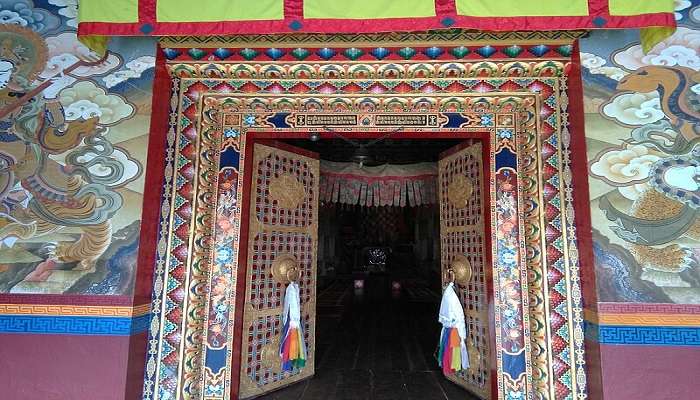
The monastery’s main temple is to the west of the entry gate. It is known as the Dukhang, which means an assembly building. It was built between 1862 and 1861 and has a large, 18-foot-tall Buddha statue. It is beautifully decorated and in a Lotus position. The head of the statue extends to the first floor. Next to the Buddha statue, a silver casket holds a particular thangka of goddess Sro devi, Palden Lhamo, the guardian deity of the monastery.
It is believed that this was painted with blood drawn from the nose of the fifth Dalai Lama, who donated this thangka, also known as Dri Devi. This temple was damaged and later renovated in 2002 in a traditional Buddhist architectural style. It was then decorated with beautiful paintings, carvings, sculptures, and murals.
Further Read: Things To Do In Arunachal Pradesh
Now that you have a list of things to remember while travelling to the Tawang Buddhist Monastery. Embark on an unforgettable journey through the mesmerising beauty of Arunachal Pradesh and reconnect with nature. Plan your next trip to Arunachal Pradesh today and forge memories you will never forget.
For our editorial codes of conduct and copyright disclaimer, please click here.
Cover Image Credit: Trideep Dutta Photography for wikimedia commons
Frequently Asked Questions About Tawang Buddhist Monastery
What is the best time to visit the Tawang Buddhist Monastery?
The best time to visit Tawang Buddhist Monastery is between March to June because the climate is pleasant and it is ideal to explore the place along with other tourist attractions nearby.
What is Tawang Buddhist Monastery famous for?
Tawang Buddhist Monastery is the largest monastery in the country. It is famous for its various interesting legends and it is located near the borders of China and Bhutan.
How to reach Tawang Buddhist Monastery?
By air, Tezpur Airport is the nearest airport, which is 350 km away from the monastery. By rail, Bhalukpong Railway Station is the closest, 280 km away. By road, there are many local buses and taxis available.
What are some places to visit near Tawang Buddhist Monastery?
A few places to visit near the monastery are Kameng River, Gorichen Peak, Madhuri Lake, Nuranang Falls, Tawang War Memorial and many more.
How much time does it require to explore the monastery?
It is a huge monastery with three floors and it takes nearly 2 to 3 hours to explore the entire monastery which has various complexes.
People Also Read:
Gyuto Tantric Monastery Sherabling Monastery Namgyal Monastery

With a passion for exploring and travelling to the roads long forgotten, experience the world through enthralling stories and adventures. Join me as I share my experiences at some of the world’s most popular tourist destinations and quench that pestering curiosity with something exciting!











